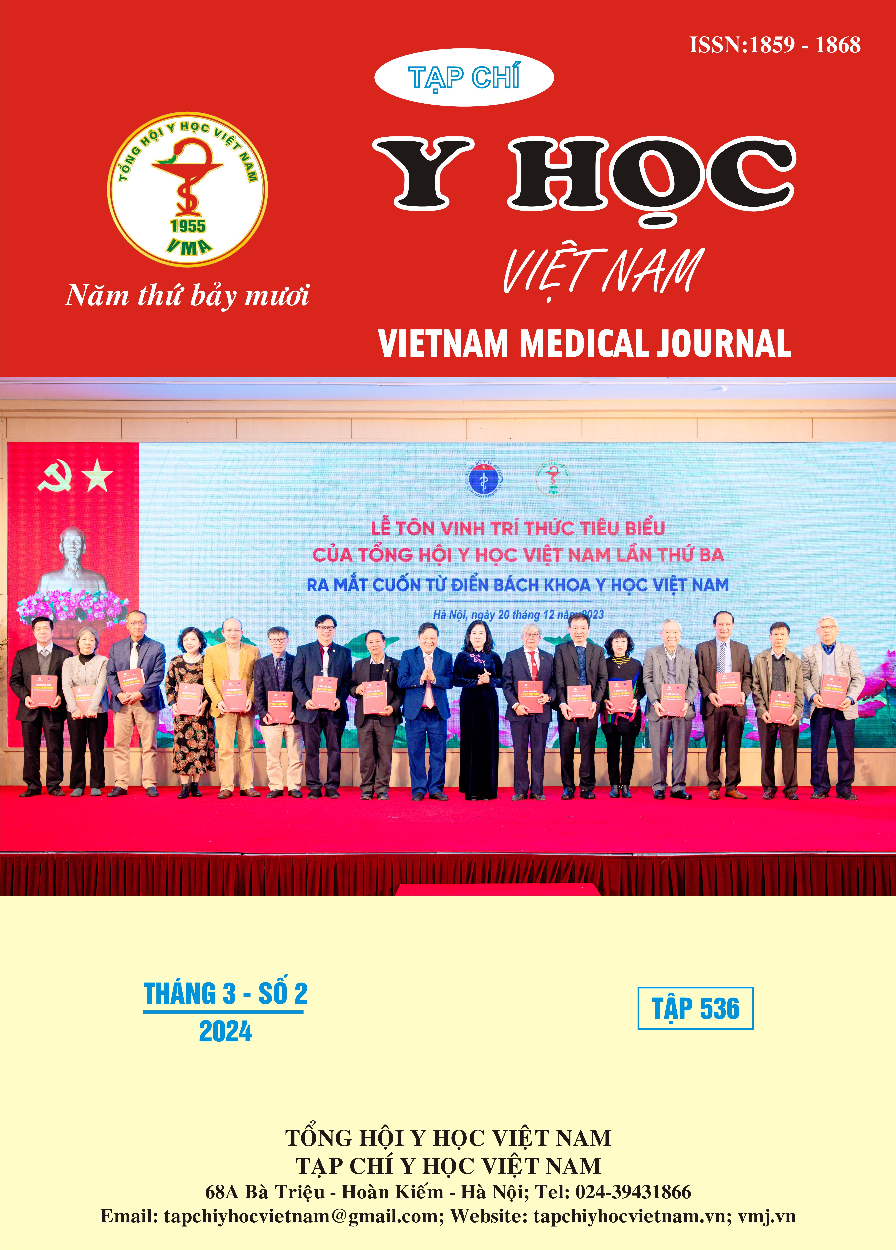CLINICAL, ENDOSCOPIC AND MULTI-SLICES CT CHARACTERISTICS OF SINUS MYCETOMA
Main Article Content
Abstract
Purposes: The aim of this study was to describe the clinical, endoscopic and multi-slice computed tomography characteristics of sinus mycetoma. Material and methods: Descriptive study on 70 patients with chronic rhinosinusitis examined at Hanoi Medical University Hospital during the period from January 2022 to July 2023. These patients were all had endoscopy and multi-slice CT scan of the sinuses, then had endoscopic sinus surgery and confirmed diagnosis of fungal sinusitis by post-operative fungal testing. Fungal sinusitis was classified based on the results of fresh fungal microscopic examination, fungal culture or post-operative pathology analysis. Results: Sinus mycetoma was diagnosed in 46/70 patients, accounting for 66%. The average age of sinus mycetoma patients was 51±12.7, the lowest was 30 y.o, the highest was 78 y.o. There were 37 females (accounting for 80.4%) and 9 males (accounting for 19.6%). The majority of patients had a healthy history (accounting for 45.7%) followed by dental diseases that underwent an endodontic treatment (accounting for 32.6%). The most common clinical symptoms were runny nose (accounting for 91.3%), stuffy nose (accounting for 73.9%), and unilateral facial pain (accounting for 65.2%). Physical symptoms on endoscopy were mainly purulent fluid on the floor or nasal recesses (accounting for 89.1%), and mucosal edema (accounting for 69.6%). The most common CT images of sinus mycetoma was the opacity in the sinus lumen (accounting for 100%), thickening of the sinus wall bone (accounting for 95.7%), and calcifications in the sinus opacity (accounting for 87%). The location of the sinuses lesion was mainly unilateral (accounting for 95.7%) and one sinus (accounting for 91.3%), of which the unilateral maxillary sinus was the most common (accounting for 80.4%). The opacity mainly occupied the entire sinus cavity (accounting for 76%) and had heterogeneous density (accounting for 97.8%). Calcification in the central opacity accounted for 80%) and the calcification morphology was mainly nodular and line (accounting for 70%). Conclusion: Sinus mycetoma was commonly occurred in women, middle-aged, progressed silently, creating opacities that occupied the entire sinus cavity, often unilateral maxillary sinus with heterogenous density, thickening of the sinus wall bone and central calcification in the opacity.
Article Details
References
2. Nomura K, Asaka D, Nakayama T, Okushi T, Matsuwaki Y, Yoshimu- ra T, et al. Sinus fungus ball in the Japanese population: clinical and imaging characteristics of 104 cases. Int J Otolaryngol. 2013;2013: 731640.
3. Jiang RS, Huang WC, Liang KL. Characteristics of sinus fungus ball: a unique form of rhinosinusitis. Clin Med Insights Ear Nose Throat. 2018 Aug;11:1179550618792254.
4. Yoon YH, Xu J, Park SK, Heo JH, Kim YM, Rha KS. A retrospective analysis of 538 sinonasal fungus ball cases treated at a single tertiary medical center in Korea (1996-2015). Int ForumAllergy Rhinol. 2017 Nov;7(11):1070-5.
5. Chen JC, Ho CY. The significance of computed tomographic findings in the diagnosis of fungus ball in the paranasal sinuses.Am J Rhinol Allergy. 2012 Mar-Apr;26(2):117-9.
6. Ho CF, Lee TJ, Wu PW, Huang CC, Chang PH, Huang YL, et al. Diagnosis of a maxillary sinus fungus ball without intralesional hyperdensity on computed tomography. Laryngoscope. 2019 May;129(5): 1041-5.
7. Seo YJ, Kim J, Kim K, Lee JG, Kim CH, Yoon JH. Radiologic charac- teristics of sinonasal fungus ball: an analysis of 119 cases. Acta Ra- diol. 2011 Sep;52(7):790-5.
8. Dhong HJ, Jung JY, Park JH. Diagnostic accuracy in sinus fungus balls: CT scan and operative findings. Am J Rhinol. 2000 Jul-Aug;14(4): 227-31.
9. deShazo RD, O’Brien M, Chapin K, Soto-Aguilar M, Swain R, Lyons M, et al. Criteria for the diagnosis of sinus mycetoma. J Allergy Clin Immunol. 1997Apr;99(4):475-85.
10. Trần Nam Khang. Đánh Giá Kết Quả Điều Trị Viêm Xoang Do Nấm Bằng Phương Pháp Phẫu Thuật Nội Soi Tại Bệnh Viện TMH TP. Hồ Chí Minh. Đại học Y dược TP Hồ Chí Minh; 2018.


